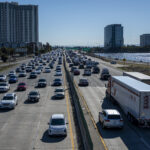Officials began inspecting bridges and roads across Hawaii yesterday, following the strongest earthquake to rattle the islands in more than two decades, a 6.6-magnitude quake that caused blackouts and landslides but no reported fatalities on Sunday, Oct. 15.
At least one stretch of road leading to a bridge near the earthquake’s epicenter on the Big Island collapsed, Civil Defense Agency spokesman Dave Curtis said.
Several other roads on the Big Island were closed by mudslides, debris and boulders, but most were still passable, he said. The power was back on across most of the islands Monday morning. About a dozen schools were closed for inspection, but no major injuries or deaths had been reported.
“If you’re going to have an earthquake, you couldn’t have had it at a better time — early in the morning when people aren’t even out of their homes yet,” Curtis said. “I think people, under the circumstances, have remained very calm.”
Nevertheless, Claire Wilkinson, spokeswoman for the Information Institute, said the New York-based organization estimates the “damage was relatively minor, but widespread.” “We can’t say what the insured losses will be — it’s too early to say — but it may exceed the $25 million threshold” for the Insurance Services Office Property Claims Service Unit’s definition of catastrophe, she said.
The quake hit at 7:07 a.m. Sunday, 10 miles (16 kilometers) north-northwest of Kailua-Kona, on the west coast of Hawaii Island, known as the Big Island, said Don Blakeman of the National Earthquake Information Center, part of the U.S. Geological Survey.
A government computer simulation estimated as many as 170 bridges could have been damaged by the quake, said Bob Fenton, Federal Emergency Management Agency director of response for the region.
Gov. Linda Lingle, who was in a hotel near the epicenter, issued a disaster declaration for the state, and the state Civil Defense had several reports of minor injuries as aftershocks continued to shake the island chain. While the quake prompted fears of a tsunami, forecasters quickly put those fears to rest, predicting only choppier-than-normal waves.
The Pacific Tsunami Center reported a preliminary magnitude of 6.5, while the U.S. Geological Survey gave a preliminary magnitude of 6.6. The earthquake was followed by several strong aftershocks, including one measuring a magnitude of 5.8, the Geological Survey said. Experts said aftershocks could continue for weeks.
“We were rocking and rolling,” said Anne LaVasseur, who was on the second floor of a two-story, wood-framed house on the east side of the Big Island when the temblor struck. “I was pretty scared. We were swaying back and forth, like King Kong’s pushing your house back and forth.”
Mayor Harry Kim estimated that as many as 3,000 people were evacuated from three hotels on the Big Island. Brad Kurokawa, Hawaii County deputy planning director, confirmed the hotels were damaged, but could not say how many people had left. They were being taken to a gymnasium until alternate accommodations could be found, he said.
The earthquake caused water pipes to explode at Aston Kona By The Sea, a condominium resort, creating a dramatic waterfall down the front of the hotel from the fourth floor, said Kenneth Piper, who runs the front desk.
“You could almost see the cars bouncing up and down in the parking garage,” Piper said.
Statewide power outages were caused because power plants turned off automatically when built-in seismic monitors were triggered by the earthquake, Lingle said. Some power had been restored late Sunday in Maui, parts of Honolulu and other places, but many remained in the dark. All electricity systems needed to be rebooted, which took several hours in more populated areas like Honolulu.
More than 50 federal officials are said to be en route to the Big Island to assess damage and begin recovery work.
Kona Community Hospital on the western side of Big Island had ceilings collapse and power cut off, according to a hospital spokeswoman. That forced at least 10 acute care patients to be evacuated across the island to a medical center in Hilo, said Terry Lewis, spokeswoman for the hospital. About 30 nursing care patients were moved temporarily to a nearby conference center, she said.
“We were very lucky that no one got hurt,” said Lewis.
The quake affected travel plans for many visitors, although the state was in its low period of the tourism season. Airports were functioning despite the power outages, although travel was difficult and some flights were being delayed or canceled, officials said.
Federal Aviation Administration spokesman Les Dorr said planes were arriving at Honolulu International Airport, but there were few departures. Dorr said the Transportation Security Administration security checkpoints were without power, so screeners were screening passengers and baggage manually.
Resorts in Kona were asked to keep people close to hotels, Kim told television station KITV. Cruise ships were told to keep tourists on board, and ships that were due to dock were asked to move on to their next location, he said.
“We are dealing with a lot of scared people,” he said.
The quake hit roughly 150 miles southwest of Honolulu’s Oahu Island, near a much less populated area. The Big Island has about 167,000 people, according to a 2005 Census estimate, and many of them live in and around Hilo, on the opposite site from where the quake was centered.
Earthquakes in the 6.0 magnitude range are rare in the region, though they have happened before. The region more commonly sees temblors in the 3- and 4-magnitude range caused by volcanic activity.
“We think this is a buildup from many volcanic earthquakes that they’ve had on the island,” Waverly Person, a geophysicist with the U.S. Geological Survey’s National Earthquake Information Center.
The last Hawaiian earthquake this strong struck more than 20 years ago. The magnitude 6.7 caused heavy property damage on Hawaii Island and collapsed trails into a volcano in Hawaiian Volcanoes National Park on Nov. 16, 1983. A 6.1-magnitude quake also hit in 1989, according to the Earthquake Information Center.
“The event underlines the importance of earthquake coverage,” III’s Wilkinson said. “Only 10 to 15 percent of U.S. homeowners have earthquake coverage,” she said. But earthquakes like this can happen anywhere, even in areas not traditionally thought of at earthquake risk. “Going without coverage is taking a huge risk,” she said.
Additional reporting by Patricia-Anne Tom.
Was this article valuable?
Here are more articles you may enjoy.

 Report: Insurers Pay $1.6B in Dog Bite Claims, as Frequency Soars
Report: Insurers Pay $1.6B in Dog Bite Claims, as Frequency Soars  Average U.S. Vehicle Age Approaching 13 Years, New Report Shows
Average U.S. Vehicle Age Approaching 13 Years, New Report Shows  23andMe Bankruptcy Bid Deadline Extended as DNA Privacy Woes Linger
23andMe Bankruptcy Bid Deadline Extended as DNA Privacy Woes Linger  California’s Ban on Gasoline Cars Is Overturned by US House Vote
California’s Ban on Gasoline Cars Is Overturned by US House Vote 